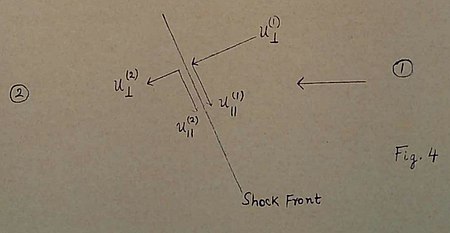Moreover these solutions will represent rigorous solutions of the problem of the Mach effect in as much as for these configurations the velocity of the gas will be parallel to the reflecting surface on both sides of the Mach front.
Configurations of the type of Figure 3 can be readily isolated from the results of the theory of the regular reflection of shock waves. This can be seen as follows:
For a given intensity of the incident shock wave, the ratio of the pressures in the region behind the reflected and in front of the incident shock waves is determinate and depends only on the angle of incidence . On the other hand, the pressure behind the Mach front under the circumstances of Fig. 3 can also be determined (as we shall see presently) from the intensity of the incident shock wave and angle . Since now the regions behind the reflected and the Mach shocks are divided only by a vortex sheet the pressures behind the reflected shock derived from the theory of reflection of shock waves must agree with that computed behind the Mach shock. This will determine as a function of the intensity of the incident shock.
To make the remarks in the preceding paragraph more specific, consider a frame of reference in which the point is at rest. Then the familiar equations of the Rankine-Hugoniot theory which relate the conditions on the two sides of a shock front can be parametrically represented as follows:

Fig. 4




